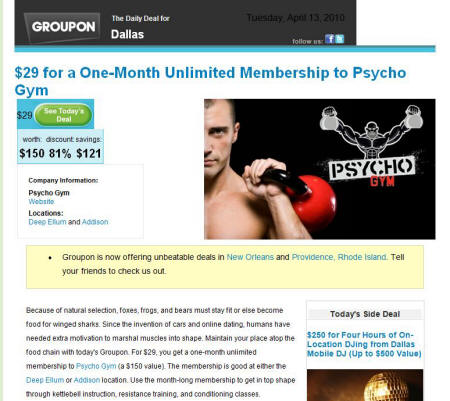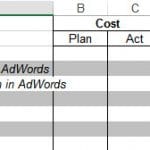This month’s tips help your health club, yoga studio or wellness center successfully tap into “daily deal” marketing strategies while avoiding the pitfalls that trip up businesses unfamiliar with this new marketing capability.
First, an overview of “daily deal” marketing services:
- “Daily deal” sites like Groupon have a big list of email addresses gathered from people who voluntarily signed up to receive marketing emails.
- Every day they email a very short list of featured, heavily discounted deals from local businesses.
- Recipients click through to buy a coupon entitling them to the daily deal. They then visit the local business to redeem the coupon and get the services they paid for.
- Groupon writes the marketing email. You and Groupon split the revenues 50/50 from coupon sales. You pay nothing upfront to Groupon.
Here’s a health club email example from Groupon:
But…watch your wallet.
Groupon’s great for consumers, because they offer huge “how low can you go” discounts on valuable services.
It isn’t always great for health clubs, yoga studios, dentists, chiropractors and wellness centers.
The first thing to understand is from the business owner’s perspective, “daily deal” promotions like these are NOT about making money off the promotion. The entire point of the promotion is repeat business, upselling and cross-selling.
So the biggest risk: you attract a lot of people who only want the incredible deal. Once they redeem their one-time “daily deal,” you never see or hear from them again and the likelihood of referrals is nearly nonexistent.
We have seen this Over and Over. It is 100% predictable, unfortunately.
You also run reputational risk – by signing up more new customers than you can handle. That’s a great way to infuriate your current clients and members. Plus, if you don’t design your special offer carefully, you can actually end up in the red, because the discounting is usually very aggressive.
1. Embrace the concept
If you can’t stand the thought of advertising based on offering a lot of stuff for a tiny price, Groupon’s not a good fit for your health club or yoga studio.
It’s also a poor fit for high-end wellness centers, health clubs and practices that emphasize personal relationships and the quality of the member or client experience.
2. Upsell and cross-sell
Most wellness businesses break even (or actually lose money) on whatever they sell through Groupon.
The only way this marketing tactic makes sense is if your yoga studio or wellness center successfully upsells or cross-sells services to these customers, or if they become loyal repeat customers after they’ve used the services they purchased through Groupon.
Data is your friend here. Do your homework, run the numbers, and see how or if it’s really turning into ongoing profit for your business.
3. Protect your core product
Don’t simply offer a truckload of your chiropractic, physical therapy or acupuncture services for a really low price. You’ll undermine the normal price for that service and attract highly price-conscious buyers who won’t be willing to pay your normal rates.
Instead, keep the usual price—but add in an impressively long list of extras to increase the value your Groupon customers feel that they’re getting.
4. Cherish your current customers
Don’t alienate your existing members and clients by temporarily overstuffing your business with people who paid almost nothing for the identical service your current clients paid full price for.
Instead, create a “daily deal” product or service that doesn’t directly correspond feature-for-feature to your existing products. Make it harder for your customers to do that head-to-head comparison.
5. Tips, tricks and traps
- Each daily deal service has a special feature or two. Make sure you use them. One might let you target a certain zipcode. Another might let you target people with a specific buying history.
- Cap the number of coupon sales you’ll allow, unless you’re offering a virtual product. You do NOT want to get slammed with negative reviews because you overcommitted and underdelivered.
- Make absolutely certain that you can promptly, with your usual quality, fulfill all the sales you’ve made—PLUS take care of your current customers.
- Line up extra staff to answer the phone on the day your Groupon email goes out.
- You can’t usually negotiate the 50% Groupon commission – but you CAN often negotiate lower commission rates (20 – 30%, for example) with Groupon’s competitors.
- If you’re using a daily-deal service other than Groupon, check their rating with the Better Business Bureau first.
- Does your deal need restrictions? For example, you may want to restrict redemption in December if that’s a busy month for you.
- Glue yourself to the comments section on your “deal” page and respond immediately (minutes, not hours and days!) to questions and concerns.
6. Reality check
After your Groupon campaign runs, track every single person who bought a coupon.
How many redeemed their coupon for yoga classes? Of those folks, how many turned into repeat customers who signed up for MORE services after they finished receiving their Groupon services? How many were never seen or heard from again?
Compare your costs to the one-time revenues from the Groupon purchases. True, you paid nothing for Groupon (other than time working with them to write the offer). But you had to purchase consumables and pay staff to provide these services.
Now, compare these costs to the recurring revenues you’ll get from the Groupon folks who became repeat customers.
What do the numbers tell you?





